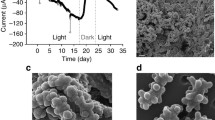Abstract
The anaerobic bacteriumChlorobium assimilates carbon dioxide in the light with various sulfur compounds as electron donors. The well-known metabolic pathway proceeds from the oxidation of sulfide via sulfur to sulfate. In the dark the reaction is partially reversed when sulfur is reduced to hydrogen sulfide. The fermenting cells thereby release an excess of reductant. We have now found a hydrogen sulfide production from sulfur, which is light-dependent. It is more than ten times faster than the dark reaction. This appears in experiments where the cell suspension is illuminated in absence of CO2 and flushed continuously with H2 or Ar. The H2S is trapped with ZnCl2 and the S2- titrated with iodine. The total amount of H2S evolved in the light increases proportionally with the amount of sulfur added, and about one-half of the added sulfur is converted to H2S. Another part of the metabolized sulfur appears at the same time as sulfate, but all the sulfur oxidized to sulfate does not account for the larger amount of sulfur reduced to hydrogen sulfide. Very likely other unanalyzed oxidized sulfur compounds must also have been produced.
Use of H2 instead of Ar as the anaerobic gas phase does not increase the amount of H2S produced, nor does the addition of thiosulfate; sulfur itself is the preferred electron donor for the sulfur reduction. Up to a light intensity of 10000 ergs cm-2sec-1 CO2 does not affect H2S production. Without CO2, saturation of the light-dependent evolution of H2S is reached at about 40000 ergs cm-2sec-1. In contrast, presence of CO2 at this light intensity makes the sulfide production disappear completely. On application of mass spectrometry to the gas exchange upon illumination, at high light intensity a H2S gush is found during the first 3 min. This is followed by CO2 fixation, while simultaneously the reductant H2S is now taken up.
WithRhodospirillum rubrum, the addition of sulfur leads to a moderate evolution of H2S. In contrast toChlorobium this reaction inR. rubrum is not light-sensitive, nor does it produce detectable amounts of sulfate. After addition of malate the rate of H2S evolution does increase in the light, since the cells use malate as an electron donor during their photochemical metabolism.
Similar content being viewed by others
References
Bethge, P. O.: On the volumetric determination of hydrogen sulfide and soluble sulfides. Analyt. chim. Acta9, 129–139 (1953)
Buchanan, B. B., Matsubara, H., Evans, M. C. W.: Ferredoxin from the photosynthetic bacteriumChlorobium thiosulfatophilum. A link to ferredoxins from nonphotosynthetic bacteria. Biochim. biophys. Acta (Amst.)189, 46–53 (1969)
Fehér, F.: Colloidal sulfur solution. In: Handbook of preparative inorganic chemistry, G. Brauer, Ed., Vol. 1, p. 343. London: Academic Press 1963
Gaffron, H.: Über die Kohlensäureassimilation der roten Schwefelbakterien. I. Biochem. Z.269, 447–453 (1934)
Gaffron, H.: Über die Kohlensäureassimilation der roten Schwefelbakterien. II. Biochem. Z.279, 1–33 (1935)
Gest, H., Ormerod, J. G., Ormerod, K. S.: Photometabolism ofRhodospirillum rubrum: Light-dependent dissimilation of organic compounds to carbon dioxide and molecular hydrogen by an anaerobic citric acid cycle. Arch. Biochem. Biophys.97, 21–33 (1962)
Hendley, D. D.: Endogenous fermentation in thiorhodaceae. J. Bact.70, 625–634 (1955)
Larsen, H.: On the microbiology and biochemistry of photosynthetic green sulfur bacteria. Kgl. Norske Videnskab. Selskabs, Skrifter, No. 1 (1953)
Ormerod, J. G., Ormerod, K. S., Gest, H.: Light-dependent utilization of organic compounds and photoproduction of molecular hydrogen by photosynthetic bacteria; relationships with nitrogen metabolism. Arch. Biochem. Biophys.94, 449–463 (1961)
Pfennig, N.: Photosynthetic bacteria. Ann. Rev. Microbiol.21, 285–324 (1967)
Pfennig, N., Lippert, K. D.: Über das Vitamin B12-Bedürfnis phototropher Schwefelbakterien. Arch. Mikrobiol.55, 245–256 (1966)
Schick, H. J.: Regulation of photoreduction inRhodospirillum rubrum by ammonia. Arch. Mikrobiol.75, 110–120 (1971)
Stanier, R. Y., Smith, J. H. C.: The chlorophylls of green bacteria. Biochim. biophys. Acta (Amst.)41, 478–484 (1960)
Steinbergs, A.: A rapid turbidimetric method for the determination of small amounts of sulfur in plant material. Analyst78, 47–53 (1953)
Stuart, T. S., Gaffron, H.: The kinetics of hydrogen photoproduction by adaptedScenedesmus. Planta (Berl.)100, 228–243 (1971)
Stuart, T. S., Gaffron, H.: The gas exchange of hydrogen-adapted algae as followed by mass spectrometry. Plant Physiol.50, 136–140 (1972)
Stuart, T. S., Herold, E. W., Gaffron, H.: A simple combination mass spectrometer inlet and oxygen electrode chamber for sampling gases dissolved in liquids. Analyt. Biochem.46, 91–100 (1972)
Trüper, H. G.: The present state of knowledge of sulfur metabolism in phototrophic bacteria. In: Abstracts of Symposium of Prokaryotic Photosynthetic Organisms, G. Drews, N. Pfennig, and R. Y. Stanier, Eds., pp. 160–166. Freiburg i. Br. 1973
Van Niel, C. B.: On the metabolism of the Thiorhodaceae. Arch. Mikrobiol.7, 323–358 (1936)
Weaver, P., Tinker, K., Valentine, R. C.: Ferredoxin linked DPN reduction by the photosynthetic bacteriaChromatium andChlorobium. Biochem. biophys. Res. Commun.21, 195–201 (1965)
Author information
Authors and Affiliations
Rights and permissions
About this article
Cite this article
Paschinger, H., Paschinger, J. & Gaffron, H. Photochemical disproportionation of sulfur into sulfide and sulfate byChlorobium limicola formathiosulfatophilum . Arch. Microbiol. 96, 341–351 (1974). https://doi.org/10.1007/BF00590189
Received:
Issue Date:
DOI: https://doi.org/10.1007/BF00590189




